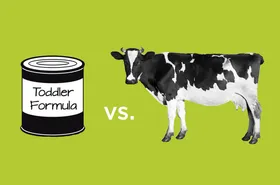5 Benefits of Omega 3s for Kids: Important Essentials for Growth
Parents, are you aware of the incredible benefits of Omega-3s for your child's growth? We've prepared the 5 essential ways these vital nutrients can positively impact your little one's development.
Updated September 13, 2024

Kids acting up? Can't sit still in class? Growing slower than their friends? You're not alone. Lots of parents are scratching their heads, wondering what's going on with their little ones.
It's tough watching your kid struggle and nothing seems to work. Supplements and crazy diets? Not fun for anyone.
But here's the solution: Omega-3s your grandma always talked about. They're an essential nutrient for children. Adding more of it to your kid's meals could be just what the doctor ordered for sharper minds and stronger bodies.
» Give your kid an omega 3 boost they need. Try baby cereal (6+ months)
What are Omega 3 Fatty Acids?
Omega-3 fatty acids are good for your little one because they support their cells, heart, brain, and hormone system. Their little body can’t make enough of them on their own, so you need to help them get these nutrients from food.
Babies who aren’t getting enough omega-3s from their mother’s milk or formula—or who have problems absorbing nutrients because of allergies—might be at risk for deficiency. Here are some of the signs:
- Dry skin
- Vision problems
- Behavioral issues
- Asthma
- Slow healing
- Weak immune system
Here are some of the foods that include omega 3s:
- Salmon
- Tuna
- Mackerel
- Sardines
- Herring
- Chia seeds
- Flaxseeds
- Walnuts
- Hemp seeds
- Soybeans and tofu
» Learn about the essential omega-3s and 6s for healthy growth
5 Omega 3 Benefits for Kids
1. Physical Health
Omega-3s can help improve cell health and reduce inflammation, which can be helpful for skin conditions, asthma, and wound healing. Researchers say that these fatty acids may improve eyesight if you combine them with lutein and zeaxanthin. [1]
You can find lutein and zeaxathin in the following foods:
- Spinach
- Kale
- Collard greens
- Eggs
- Corn
- Oranges
- Grapes
- Papaya
- Okra
- Bell peppers
» Get easy tips to include healthy fats into your kid's diet
2. Cognitive Development
Omega-3s are essential for our kids’ brains, just like they are for their eyes. [2] These special fats help with learning, concentration, and memory. So, they might help help your little one do well in school.
These fatty acids can also help with some issues that kids with ADHD have, which can slow them down when learning. But it’s important to know that research on this is still underway. [3]
3. Emotional Health
Some studies have found that omega-3 supplements may support emotional regulation, easing drastic mood swings, depression, and anxiety. [4] But, we need more research because the current evidence is inconclusive.
» Learn all about the macronutrient deficiencies in the first 1000 days of life
4. Asthma
A pilot study found that fish oil, rich in omega-3 fatty acids, helped improve lung function in asthma patients over four weeks. They measured it by tracking how quickly participants exhaled.
But, another study didn't find significant improvements in how easily the airways narrow or overall asthma control with omega-3 supplements. [5]
Finally, a larger analysis of multiple studies showed that moms taking omega-3 supplements during pregnancy could lower their children's risk of asthma or wheezing. [6] This is especially true for children whose families have a history of allergies.
» Learn more about nutrition during pregnancy
5. Sleep
Some studies suggest that omega-3 supplements might improve sleep quality in certain children, like those with ADHD or autism. [7] For example, one review found that omega-3s were especially helpful for treating hyperactivity in autistic children.
A larger analysis of studies also showed that omega-3s could promote healthier sleep in infants. [8] The evidence comes from both controlled trials and long-term studies.
Get Your Baby the Omega-3 Boost They Need
Organic rapeseed oil is also a known source of omega-3s, especially alpha-linolenic acid (ALA)—and Else Nutrition Baby Super Cereal has it. ALA is a plant-based omega-3 that your little one's body can convert into EPA and DHA fatty acids, which are essential for brain and eye development.
Here's why our customers love it:
But don't you want to know about the rest of the ingredients? Else Baby Cereal is made from over 80% buckwheat, tapioca, and almond butter. It's the only US cereal with the Clean Label Project Certification.
So, what does the certification mean? Well, first, you won't need to waste your time checking the label at the back and wondering if it's healthy. Second, it recognizes our product as free from:
- Corn syrup
- Heavy metals
- Arsenic
- Flavorings
- Additives
- GMOs
- Dairy
- Gluten
- Soy
Browse our cereal selection and find the best flavor for your little one
When Should Kids Start Taking Omega 3?
Omega-3s are essential for everyone, from birth to old age. But the first five years of life are especially important for proper development.
Fatty fish like tuna, salmon, mackerel, anchovies, sardines, and seaweed are great sources of omega-3s. Nuts, seeds, and spinach also contain omega-3s, but they have more ALA than DHA and EPA, which are the types found in fish. That's why doctors recommend eating it.
Supplements can be helpful for kids who don't get enough omega-3s from their food, but consult your pediatrician to know for sure.
Here's a recommended daily intake of omega-3s for children [9]:
- 0-1 years old: 0.5 grams
- 1-3 years old: 0.7 grams
- 4-8 years old: 0.9 grams
» Check out the best feeding schedule for 1-year-olds
Omega 3: Essential Nutrient or Overblown Hype?
As we discuss omega-3s, it's clear that there's no single best way to ensure optimal child development. Today, parents often feel pressure to give their kids everything they need. Omega-3s are a tempting solution, but the real lesson might not be about a specific nutrient.
It's about finding balance and enjoying feeding our children. Simple pleasures like sharing a meal of grilled fish or a handful of nuts can be just as important. So, let's relax and trust that we're doing our best. After all, isn't that what we're all striving for?
References:
- F. J. Schweigert and J. Reimann, “Mikronährstoffe und ihre Bedeutung für das Auge – Wirkungsweise von Lutein/Zeaxanthin und Omega-3-Fettsäuren,” Klinische Monatsblätter Für Augenheilkunde, vol. 228, no. 06, pp. 537–543, Aug. 2010, doi: 10.1055/s-0029-1245527. Available: https://pubmed.ncbi.nlm.nih.gov/20740395/
- R. V. Gow and J. R. Hibbeln, “Omega-3 fatty acid and nutrient deficits in adverse neurodevelopment and childhood behaviors,” Child and Adolescent Psychiatric Clinics of North America, vol. 23, no. 3, pp. 555–590, Jul. 2014, doi: 10.1016/j.chc.2014.02.002. Available: https://www.ncbi.nlm.nih.gov/pmc/articles/PMC4175558/
- “Mayo Clinic Q and A: Omega-3 supplements for children — what does the research show?” Available: https://newsnetwork.mayoclinic.org/discussion/mayo-clinic-q-and-a-omega-3-supplements-for-children-what-does-the-research-show/
- N. M. Reily, S. Tang, A. Negrone, D. Z. Q. Gan, V. Sheanoda, and H. Christensen, “Omega-3 supplements in the prevention and treatment of youth depression and anxiety symptoms: A scoping review,” PLoS ONE, vol. 18, no. 4, p. e0284057, Apr. 2023, doi: 10.1371/journal.pone.0284057. Available: https://www.ncbi.nlm.nih.gov/pmc/articles/PMC10118139/
- J. D. Brannan et al., “The effect of omega-3 fatty acids on bronchial hyperresponsiveness, sputum eosinophilia, and mast cell mediators in asthma,” CHEST Journal, vol. 147, no. 2, pp. 397–405, Feb. 2015, doi: 10.1378/chest.14-1214. Available: https://pubmed.ncbi.nlm.nih.gov/25321659/
- K. A. Lee-Sarwar et al., “Omega-3 Fatty Acids Interact with DPP10 Region Genotype in Association with Childhood Atopy,” Nutrients, vol. 15, no. 10, p. 2416, May 2023, doi: 10.3390/nu15102416. Available: https://www.ncbi.nlm.nih.gov/pmc/articles/PMC10223962/
- K. Jafarian, S. Nachvak, and H. Salehi, “A Review on the Effects of Omega-3 Supplementation on Sleep Patterns, Hyperactivity and other Developmental Behavior in Children with Autism Spectrum Disorders,” 2013. Available: https://www.semanticscholar.org/paper/A-Review-on-the-Effects-of-Omega-3-Supplementation-Jafarian-Nachvak/f7b99f60a3ce37849a9b33df6c8e82118cd29683
- K. Jafarian, S. Nachvak, and H. Salehi, “A Review on the Effects of Omega-3 Supplementation on Sleep Patterns, Hyperactivity and other Developmental Behavior in Children with Autism Spectrum Disorders,” 2013. Available: https://www.semanticscholar.org/paper/A-Review-on-the-Effects-of-Omega-3-Supplementation-Jafarian-Nachvak/f7b99f60a3ce37849a9b33df6c8e82118cd29683
- “Office of Dietary Supplements - Omega-3 fatty acids.” Available: https://ods.od.nih.gov/factsheets/Omega3FattyAcids-HealthProfessional/
Disclaimer: The content and advice provided in this article are for informational purposes only and are not a substitute for medical diagnosis, treatment, or advice for specific medical conditions. Always consult a pediatrician to understand your child's individual needs.










